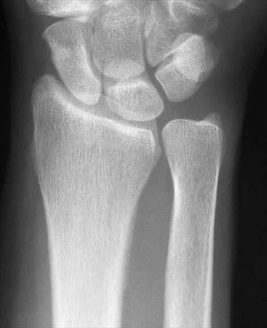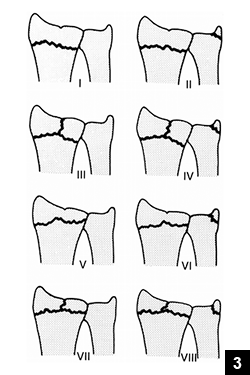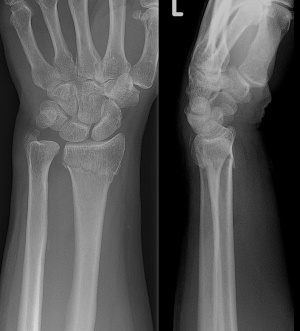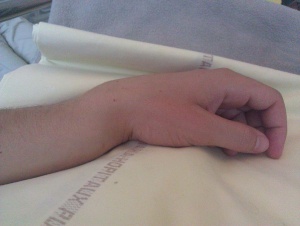Colles Fracture: Difference between revisions
No edit summary |
No edit summary |
||
| Line 89: | Line 89: | ||
* Comminution at the fracture site | * Comminution at the fracture site | ||
* Associated fracture of the ulnar styloid process in more than 60% of cases.<ref>Sarwark, John F. Rosemont, Ill.: American Academy of Orthopaedic Surgeons. 2010</ref> | * Associated fracture of the ulnar styloid process in more than 60% of cases.<ref>Sarwark, John F. Rosemont, Ill.: American Academy of Orthopaedic Surgeons. 2010</ref> | ||
== Differential Diagnosis/ Associated Injuries == | |||
* Scapholunate ligament tear | |||
* Median nerve injury | |||
* TFCC (triangular fibrocartilage complex) injury, up to 50% when ulnar styloid fx also present | |||
* Carpal ligment injury:Scapholunate Instability(most common), lunotriquetral ligament | |||
* Tendon injury,attritional EPL rupture, usually treated with EIP tendon transfer | |||
* Compartment syndrome | |||
* Ulnar styloid fracture | |||
* DRUJ (Distal Radial Ulnar Joint) Instability | |||
* Galeazzi Fracture: highly associated with distal 1/3 radial shaft fractures<ref>https://www.eorif.com/colles-fracture</ref> | |||
== Outcome Measures == | == Outcome Measures == | ||
| Line 96: | Line 107: | ||
*Green Score | *Green Score | ||
*O'Brian Score <ref name="MacDermid">MacDermid JC, Roth JH, Richards RS. Pain and disability reported in the year following a distal radius fracture: a cohort study. BMC Musculoskeletal Disord. 2003;4:24.</ref><ref name="Arora">Arora R, Gabl M, Gschwentner M, Deml C, Krappinger D, Lutz M. A comparative study of clinical and radiologic outcomes of unstable colles type distal radius fractures in patients older than 70 years: nonoperative treatment versus volar locking plating. J Orthop Trauma. 2009;23(4):237-242.</ref><ref name="Wright">Wright TW, Horodyski M, Smith DW. Functional outcome of unstable distal radius fractures: ORIF with a volar fixed-angle tine plate versus external fixation. J Hand Surg Am. 2005;30(2):289-299.</ref><ref name="Tremayne">Tremayne A, Taylor N, McBurney H, Baskus K. Correlation of impairment and activity limitation after wrist fracture. Physiother Res Int. 2002;7(2):90-99.</ref> | *O'Brian Score <ref name="MacDermid">MacDermid JC, Roth JH, Richards RS. Pain and disability reported in the year following a distal radius fracture: a cohort study. BMC Musculoskeletal Disord. 2003;4:24.</ref><ref name="Arora">Arora R, Gabl M, Gschwentner M, Deml C, Krappinger D, Lutz M. A comparative study of clinical and radiologic outcomes of unstable colles type distal radius fractures in patients older than 70 years: nonoperative treatment versus volar locking plating. J Orthop Trauma. 2009;23(4):237-242.</ref><ref name="Wright">Wright TW, Horodyski M, Smith DW. Functional outcome of unstable distal radius fractures: ORIF with a volar fixed-angle tine plate versus external fixation. J Hand Surg Am. 2005;30(2):289-299.</ref><ref name="Tremayne">Tremayne A, Taylor N, McBurney H, Baskus K. Correlation of impairment and activity limitation after wrist fracture. Physiother Res Int. 2002;7(2):90-99.</ref> | ||
== Medical management == | == Medical management == | ||
Revision as of 18:03, 10 October 2017
Original Editor - Stacy S Stone
Top Contributors - Emma Guettard, Admin, Adam Vallely Farrell, Kim Jackson, Stacy S Stone, Laura Ritchie, Rachael Lowe, Anne-Laure Vanherwegen, Nikhil Benhur Abburi, Lauren Lopez, Lucinda hampton, WikiSysop, Claire Knott, Anas Mohamed, Evan Thomas, Scott Buxton, Priyanka Chugh and Benjamin Desmedt - Emma Guettard as part of the Vrije Universiteit Brussel Evidence-based Practice Project
Definition/Description[edit | edit source]
A true Colles Fracture is a complete fracture of the radius bone of the forearm close to the wrist resulting in an upward (posterior) displacement of the radius and obvious deformity. It is commonly called a “broken wrist” in spite of the fact that the distal radius is the location of the fracture, not the carpal bones of the wrist.[1]
The Colles fracture is named after Abraham Colles, an Irish surgeon, who first described it in 1814 by simply looking at the classical deformity before the advent of X-rays
The fracture originates from a fall on the outstretched hand and is usually associated with dorsal and radial displacement of the distal fragment, and disturbance of the radial-ulnar articulation. Possibly the ulnar styliod may be fractured. Communication of the distal fragment and fractures into the joint surface are present in some of these fractures. The colles fracture is one of the most common and challenging of the outpatient fractures[2]. Colles' fracture is defined as a linear transverse fracture of the distal radius approximately 20-35 mm proximal to the articular surface with dorsal angulation of the distal fragment[3].
Clinical relevant anatomy[edit | edit source]

The distal radius forms the proximal side of the wrist joint. There, the radius articulates with the proximal row of carpal bones (allowing flexion and extension); it also articulates with the distal ulna (creating a joint for pronation and supination).
The distal ulna attaches to a meniscus-like structure, the triangular fibrocartilage discus, which can be torn with wrist fractures.
On the lateral side of the radius is a styloid process, onto which the brachioradialis inserts and from which the radial collateral ligament of the wrist originates.
At the distal metaphysis of the radius, the cortex of the bone is thinner than the bone proximal and distal, and the relative amount of cancellous bone increases. The distal metaphysis of the radius is therefore a relative weak point. This make fractures more likely, especially in patients with decreased bone mineral density.[5]
Low energy extra-articular fracture of the distal radius. Can be associated with ulnar styloid fracture, TFCC tear, scapholunate dissociation.[6]
For further information on the Anatomy and assessment of the wrist
Epidemiology/Etiology[edit | edit source]
Females are predilected more than males for this type of injury and oftentimes there is a precedent history of osteoporosis.' In the United States and in Northern Europe, colles fractures are the most common fractures in women up to the age of 75 years[7]. It is known that these fractures appear mostly by young adults and the elderly[8]. Stable Colles' fractures present with minimal comminution. Unstable fractures are distinctly comminuted often with corresponding avulsions of the radial or ulnar styloid, that have the potential to cause compression neuropathies, especially of the median nerve. Other complications that have been reported are degenerative joint disease and reflex sympathetic dystrophy[3].
Colles fractures are the most common type of distal radial fracture and are seen in all adult age groups and demographics. They are particularly common in patients with osteoporosis, and as such, they are most frequently seen in elderly women. The relationship between Colles fractures and osteoporosis is strong enough that when an older male patient presents with a Colles fracture, he should be investigated for osteoporosis because his risk of a hip fracture is also elevated. [9]
Younger patients who sustain Colles fractures have usually been involved in high impact trauma or have fallen, e.g. during contact sports, skiing, horse riding. [9]
Younger patients have stronger bone, and thus, more energy is required to create a fracture in these individuals. Motorcycle accidents, falls from a height, and similar situations are common causes of a DRF. Trauma is the leading cause of death in the 15- to 24-year-old age group, and this is also reflected in the incidence of lesser traumas.
Older patients have much weaker bones and can sustain a DRF from simply falling on an outstretched hand in a ground-level fall. An increasing awareness of osteoporosis has led to these injuries being termed fragility fractures, with the implication that a workup for osteoporosis should be a standard part of treatment. As the population lives longer, the frequency of this type of fracture will increase.
Characteristics/clinical presentation[edit | edit source]
The clinical presentation of Colles fracture is commonly described as a dinner fork deformity. A distal fracture of the radius causes posterior displacement of the distal fragment, causing the forearm to be angled posteriorly just proximal to the wrist. With the hand displaying its normal forward arch, the patient’s forearm and hand resemble the curvature of a dinner fork.
- "Dinner Fork" Deformity[10]
- History of fall on an outstretched hand
- Dorsal wrist pain
- Swelling of the wrist
- Increased angulation of the distal radius
- Inability to grasp object[11]
Signs and Symptoms- Pain, numbness, tenderness, bruising, deformity of wrist.
Frykman Classification[edit | edit source]

Gosta Frykman identified many different forms of Colles fracture and classified it into eight different types based on the extra- or intra-articular nature of fractures involving the distal ends of the radius and ulna.
- type I: transverse metaphyseal fracture
- includes both Colles and Smith fractures as angulation is not a feature
- type II: type I + ulnar styloid fracture
- type III: fracture involves the radiocarpal joint
- includes both Barton and reverse Barton fractures
- includes Chauffeur fractures
- type IV: type III + ulnar styloid fracture
- type V: transverse fracture involves distal radioulnar joint
- type VI: type V + ulnar styloid fracture
- type VII: comminuted fracture with the involvement of both the radiocarpal and radioulnar joints
- type VIII: type VII + ulnar styloid fracture[13][14]
Although it appears complicated, there is only a four-type classification (odd numbered types) with each type having a subtype which includes ulnar styloid fracture (the even numbered types)
Patients frequently heal well with no complications. If redisplacement of the Colles fracture is seen a few weeks after reduction, it's important to take and check radiographs a week-10 days after injury. Possible complications may include:
- malunion
- persistent translation of the carpus
- shortening of radius
- stiffness of the wrist and the forearm
Few very rare complications are carpal tunnel syndrome, Sudeck's atrophy and ulnar and radial compression neuropathy.[15]
Diagnosis[edit | edit source]

A careful history including the mechanism of injury establishes suspicion for a Colles fracture. Diagnosis is most often made upon interpretation of pasteroanterior and lateral views alone.[17]
The classic Colles fracture has the following characteristics;
- Transverse fracture of the radius
- 2.5 cm (0.98 inches) proximal to the radio-carpal joint
- dorsal displacement and dorsal angulation, together with radial tilt
Other characteristics on plain radiographs may include:
- Radial shortening
- Loss of ulnar inclination
- Radial angulation of the wrist
- Comminution at the fracture site
- Associated fracture of the ulnar styloid process in more than 60% of cases.[18]
Differential Diagnosis/ Associated Injuries[edit | edit source]
- Scapholunate ligament tear
- Median nerve injury
- TFCC (triangular fibrocartilage complex) injury, up to 50% when ulnar styloid fx also present
- Carpal ligment injury:Scapholunate Instability(most common), lunotriquetral ligament
- Tendon injury,attritional EPL rupture, usually treated with EIP tendon transfer
- Compartment syndrome
- Ulnar styloid fracture
- DRUJ (Distal Radial Ulnar Joint) Instability
- Galeazzi Fracture: highly associated with distal 1/3 radial shaft fractures[19]
Outcome Measures[edit | edit source]
Medical management[edit | edit source]
| [23] |
The treatment of Colles fractures will depend on the type of Colles fracture present, the age and activity level of the patient, the surgeon’s preference, and the patient’ s desires regarding immobilization and return to activity. As Colles fractures are so common, many methods of treatment have been developed to stabilize the fractures and allow the bone to heal. The ultimate goal is to return the wrist to its prior level of functioning.
Management of a Colle's fracture depends on the severity of the fracture. An undisplaced fracture may be treated conservatively with a cast alone. The cast is applied with the distal fragment in palmar flexion and ulnar deviation.
Surgical options can include: external fixation, internal fixation, percutaneous pinning, and bone substitutes.
A fracture with mild angulation and displacement may require closed reduction. Significant angulation and deformity may require an open reduction and internal fixation or external fixation. The volar forearm splint is best for temporary immobilization of forearm, wrist and hand fractures, including Colles fracture.
A higher amount of instability criteria increases the likelihood of operative treatment.
The fracture pattern, degree of displacement, the stability of the fracture, and the age and physical demands of the patient will all be considered when determininmg the best treatment option[24][25]
Physical therapy [edit | edit source]
Rehabilitation protocol for Colles’ fracture[edit | edit source]
Passive:[edit | edit source]
A case report used a rehabilitation protocol to improve range of motion and grip strength in an undisplaced, stable Colles' fracture. The patient got a treatment with passive interventions to improve circulation and prevent immobilization adhesion formation. These treatments included application of an ice pack to reduce edema followed by application of a wax bath on the affected wrist. Gentle range of motion mobilizations were then introduced that could only be performed in flexion and extension to the patient's pain tolerance. Three sets of 5 flexion/extension repetitions were performed on the affected wrist. The joint was also mobilized in circumduction, ulnar flexion and radial flexion to the patient's level of tolerance.
Early mobilisation resulted in rapid recovery of both movement and strength without causing more discomfort or adversely influencing the progression of the deformity. In patients over 55, minimally displaced fractures can safely be treated in a crepe bandage, and displaced fractures which have been reduced can be treated in a modified cast. Early mobilisation would ensure rapid recovery of wrist and hand function while avoiding the complications of a conventional plaster cast[26].
This study [26] proved that in the groups with displaced and undisplaced fractures, the recovery of forearm rotation and finger movement paralleled the recovery of wrist movement: for both types of fracture, early mobilisation led to an earlier return of strength. Although this recovery did not parallel the improvement in wrist movement.
In both categories early mobilization led to more rapid resolution of wrist swelling in the first five weeks. At nine weeks and at 13 weeks the wrist girths were similar.
Patients encouraged to mobilise the injured wrist from the outset recovered wrist movement more quickly than those who were immobilized in a conventional plaster cast.[26]
Supervised Active rehabilitation program:[edit | edit source]
- ISOMETRIC EXERCISE
- wrist flexors and extensors
- ACTIVE RANGE OF MOTION EXERCISE
- assisted stretch to forearm flexors and extensor musculature and radial/ulnar deviation
- weight bearing wrist extension exercise(hand on the table with the patient leaning forward on them) to patient tolerance
- active stretch to shoulder girdle and rotator cuff musculature
- active stretch to elbow flexor and extensor musculature
- INTRINSIC HAND MUSCLE EXERCISE
- thumb/digit opposition
- repetitive squeezing of theraputty
- repetitive towel wringing exercise
- STRENGTHENING ROUTINE
- biceps curl with 1,5-2 pound weights bilaterally
- shoulder abduction, flexion and extension reps with 2 pound weights bilaterally
- repetitive squeezing of rubber ball in affected wrist
- flexion and extension of wrist using 1,5 pound weights increasing as tolerated
- FUNCTIONAL ACTIVITIES
- patient is encouraged to resume pre-accident activities that involve the affected extremity (eg. writing, typing, cooking, etc.)
In addition the patient in this case study[3] was encouraged to resume functional activities that involve the wrist and hand such as writing, cooking and sewing.
In the study of Gupta A. fractures immobilised with the wrist in dorsiflexion had the best results.
Comparison of various joint movements with those on the uninjured side showed that fractures who were immobilised in palmar flexion had more joint stiffness, particularly of the metacarpophalangeal and interphalangeal joints. Even in type 3 fractures (displaced,extra-articular with communition), where the position of immobilization of the wrist did not significantly effect the anatomical result, immobilization in dorsiflexion provided the best recovery of function[27].
In the study[28] it is proved that the addition of occupational therapy to instruction therapy reaches no statistical significance for following variables. Parameters examined were the dorsal angulation, the radial angulation and the axial radial length.
Functional scores were measured such as the modified Gartland and Werley score, but there were no statistical differences.
The instruction therapy consists of the following activities: a warm-up for 10 min in warm soap-water, raising and lowering the shoulders, rotating the shoulders, bending and stretching the fingers, spreading and joining the fingers, reaching the fingertips with the thumb, reaching the finger base with the thumb, turning the back and palm of the hand with the elbow fixed at the side and finally bending the wrist with the hand over the side of a table. The occupational therapy includes active joint exercises for wrist, elbow and shoulder, edema prevention, coordination exercise, coarse and fine motor-function exercise, strengthening exercise, sensation exercise and ADL training[28].
Exercises to increase ROM:
Active assisted range of motion (AAROM)
AAROM Extension
- With the hand facing down and the forearm supported on a table, the uninjured hand should aid the injured wrist into extension as demonstrated in the picture to the left
- The fingers should be pushed back so as they eventually point towards the ceiling
- Complete 15-20 times 2-3 times daily.
AAROM Flexion
- With the hand facing down and the forearm supported on a table, the uninjured hand should aid the injured wrist into flexion as demonstrated in the picture to the left.
- The fingers should be pushed back so as they eventually point towards the ceiling.
- Complete 15-20 times 2-3 times daily.
Ulnar and Radial Deviation
- Place the hand face down on a flat surface, with the forearm supported and fingers straight.
- Without moving the forearm, move the hand towards the thumb without lifting it off the surface.
- Complete this movement in the opposite direction towards the small finger.
- Complete 15-20 times 2-3 times daily.
Active of motion (AROM) exercises
Wrist Flexion
Wrist Extension
Ulnar and Radial deviation
Pronation and Supination of the forearm
Stretching exercises
Wrist Flexion stretch
- The wrist flexion stretch can be completed with the support of a flat surface or through the use of the other hand.
- The stretch must be held for a minimum of 35 seconds.
Wrist Extension stretch
- The wrist extension stretch can be done in either positions shown, with the support of a flat surface or the use of the other hand.
- The stretch must be held for a minimum of 35 seconds.
Strengthening exercises
Flexion and extension exercises
- Flexion exercise- Using a dumbbell or a theraband, position the hand facing up over the edge of a table.
- Complete 3 sets of 6 reps in a slow and controlled manner.
- Extension exercise- Using a dumbbell or a theraband, position the hand facing down over the edge of a table.
- Complete 3 sets of 6 reps in a slow and controlled manner
Wrist Pronation and Supination strengthening exercises
- Using a hammer as shown or a dumbbell, position the forearm on a flat surface.
- Slowly move the hammer from left to right without moving the forearm from its position.
- Complete in a slow and controlled manner for 3 sets of 6 reps.
Grip Strength exercises
- Using putty or a sponge, squeeze the putty with the fingers against the palm of the hand in a kneading motion, exerting as much pressure as possible against the resistance of the putty. This should be done for as long as can be tolerated at numerous intervals throughout the day.
Key Research[edit | edit source]
- Arora R, Gabl M, Gschwentner M, Deml C, Krappinger D, Lutz M. A comparative study of clinical and radiologic outcomes of unstable colles type distal radius fractures in patients older than 70 years: nonoperative treatment versus volar locking plating. J Orthop Trauma. 2009;23(4):237-42. (level of evidence 2b)
- Wright TW, Horodyski M, Smith DW. Functional outcome of unstable distal radius fractures: ORIF with a volar fixed-angle tine plate versus external fixation. J Hand Surg Am. 2005;30(2):289-99.(level of evidence 1b)
- Handoll HH, Huntley JS, Madhok R. External fixation versus conservative treatment for distal radial fractures in adults. Cochrane Database Syst Rev. 2007 Jul 18;(3):CD006194.(level of evidence 1a)
- Gehrmann SV, Windolf J, Kaufmann RA. Distal radius fracture management in elderly patients: a literature review. J Hand Surg Am. 2008;33(3):421-9.(level of evidence 2a)
References[edit | edit source]
- ↑ http://www.handandwristinstitute.com/colles-fracture/
- ↑ T. M. Molder, E. Vernon Stabler, M.D., and William H. Cassebaum,M.D.; Colles fracture: evaluation and selection of the therapy; the journal of trauma and acute case surgery. 1965; volume 5 issue 4.(Level of Evidence 1B)
- ↑ 3.0 3.1 3.2 Stephen Balsky, Rehabilitation protocol for undisplaced Colles' fractures following cast removal, the journal of the Canadian chiropractic association.(Level of evidence 4)
- ↑ http://emedicine.medscape.com/article/1245884-overview#a11
- ↑ http://www.orthopaedicsone.com/display/MSKMed/Distal+radius+%28Colles%29+fractures
- ↑ 6.0 6.1 MacDermid JC, Roth JH, Richards RS. Pain and disability reported in the year following a distal radius fracture: a cohort study. BMC Musculoskeletal Disord. 2003;4:24.
- ↑ Owen RA, Melton LJ, 3rd, Johnson KA, Ilstrup DM, Riggs BL., Incidence of Colles’ fracture in a North American community. Am J Public Health. 1982;72(6):605–607.
- ↑ Cummings SR, Kelsey JL, Nevitt MC, O’Dowd KJ., Epidemiology of osteoporosis and osteoporotic fractures. Epidemiol Rev. 1985;7:178–208.
- ↑ 9.0 9.1 Munk PL, Munk P, Ryan A. Teaching Atlas of Musculoskeletal Imaging. Thieme Medical Pub. (2007) ISBN:1588903729.
- ↑ Hoynak BC, Hopson L. EMedicine. Wrist Fractures.http://emedicine.medscape.com/article/828746-overview (Acessed 2 July 2009).
- ↑ Joseph TN. Medline Plus. Colles' Wrist Fracture.http://www.nlm.nih.gov/medlineplus/ency/article/000002.htm (Accessed 2 July 2009).
- ↑ http://emedicine.medscape.com/article/1245884-overview#a11
- ↑ Bohndorf K, Imhof H, Pope TL. Musculoskeletal Imaging, A Concise Multimodality Approach. George Thieme Verlag. (2001) ISBN:1588900606.
- ↑ Reiser M, Baur-Melnyk A. Musculoskeletal Imaging. TIS. (2008) ISBN:3131493410.
- ↑ https://www.kenhub.com/en/library/anatomy/colles-fracture
- ↑ https://commons.wikimedia.org/wiki/File%3ACollesfracture.jpg
- ↑ Adam,, Greenspan,. Orthopedic imaging : a practical approach. Beltran, Javier (Professor of radiology), (Sixth edition ed.). Philadelphia.
- ↑ Sarwark, John F. Rosemont, Ill.: American Academy of Orthopaedic Surgeons. 2010
- ↑ https://www.eorif.com/colles-fracture
- ↑ Arora R, Gabl M, Gschwentner M, Deml C, Krappinger D, Lutz M. A comparative study of clinical and radiologic outcomes of unstable colles type distal radius fractures in patients older than 70 years: nonoperative treatment versus volar locking plating. J Orthop Trauma. 2009;23(4):237-242.
- ↑ Wright TW, Horodyski M, Smith DW. Functional outcome of unstable distal radius fractures: ORIF with a volar fixed-angle tine plate versus external fixation. J Hand Surg Am. 2005;30(2):289-299.
- ↑ Tremayne A, Taylor N, McBurney H, Baskus K. Correlation of impairment and activity limitation after wrist fracture. Physiother Res Int. 2002;7(2):90-99.
- ↑ besthandsurgeon. Distal Radius Fracture ORIF. Available from: http://www.youtube.com/watch?v=Ye839BYoMaY[last accessed 22/03/13]
- ↑ Wheeless CR. Wheeless' Textbook of Orthopaedics. Colles Fracture. http://www.wheelessonline.com/ortho/colles_frx(Accessed 2 July 2009)
- ↑ https://en.wikipedia.org/wiki/Colles%27_fracture
- ↑ 26.0 26.1 26.2 Dias JJ, Wray CC, Jones JM, Gregg PJ. The value of early mobilisation in the treatment of Colles' fractures. 1987;69(3); 463-7. (level of evidence 1a)
- ↑ Gupta A., The treatment of Colles' fracture. Immobilisation with the wrist dorsiflexed. 1991;73(2):312-5.(level of evidence 1b)
- ↑ 28.0 28.1 O.M. Christensen (2000) Occupational therapy and Colles’ fractures, International Orthopaedics (SICOT). 2001;25:43–45 (level of evidence 1b)







